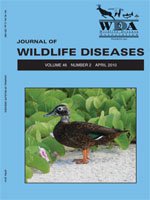Between 1990 and 2007, carcasses of opportunistically collected short-beaked common dolphins (Delphinus delphis; n=238), Indo-Pacific bottlenose dolphins (Tursiops aduncus; n=167), and common bottlenose dolphins (Tursiops truncatus; n=15) were examined for parasites and life history data. Three species of lung nematodes (Halocercus lagenorhynchi, Stenurus ovatus, Pharurus alatus) were identified in surface nodules, subsurface lesions, or airways. Nematode burdens were light to heavy and, in many cases, would have compromised the dolphins' health. The number of dolphins infected was related to species, year, season, age class, and geographic region. Nematodes were found in all three species but were more prevalent in short-beaked common dolphins (mean annual prevalence=26%) than in bottlenose dolphins (12%). There was a significant increase in prevalence of nematodes in short-beaked common dolphins in 2005–06 (63%) compared to 1990–2004 (14%), with a peak in April–June. More young short-beaked common dolphins were infected than subadults and adults and, during the unusual infection event, there were more dependent calves (<130 cm) than juveniles. There were also more infections in dependent bottlenose dolphin (Tursiops spp.) calves but no increase in overall prevalence was detected during 2005–06. Because neonates of both short-beaked common dolphins and bottlenose dolphins were infected, mother-to-calf transmission is suspected for these species in South Australia. Numbers of infections in short-beaked common dolphins were higher in Gulf St Vincent than elsewhere in South Australia, particularly in 2005–06. The cause of the unusual infection event in short-beaked common dolphins is unknown. We discuss the influence of dolphin diet, life history, and external factors.
How to translate text using browser tools
1 April 2010
EIGHTEEN-YEAR STUDY OF SOUTH AUSTRALIAN DOLPHINS SHOWS VARIATION IN LUNG NEMATODES BY SEASON, YEAR, AGE CLASS, AND LOCATION
Ikuko Tomo,
Catherine M. Kemper,
Trish J. Lavery
ACCESS THE FULL ARTICLE

Journal of Wildlife Diseases
Vol. 46 • No. 2
April 2010
Vol. 46 • No. 2
April 2010
Delphinus delphis
host age
lung worm
Pseudaliidae
Seasonality
South Australia
Tursiops aduncus




